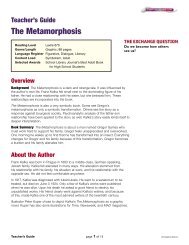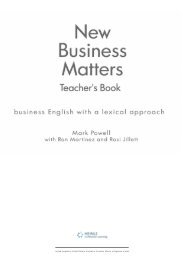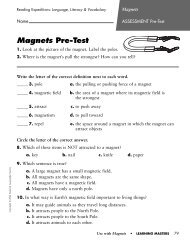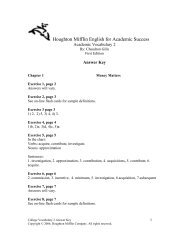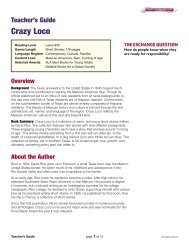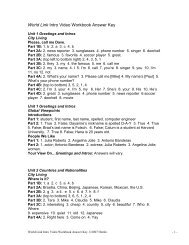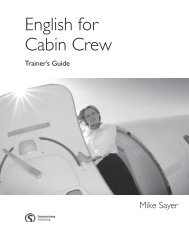Weaving It Together
Weaving It Together
Weaving It Together
You also want an ePaper? Increase the reach of your titles
YUMPU automatically turns print PDFs into web optimized ePapers that Google loves.
Sample Lesson Plan<br />
Each chapter in <strong>Weaving</strong> <strong>It</strong> <strong>Together</strong>, Book 3,<br />
follows a carefully designed sequence of<br />
activities, which guides students through<br />
the process of connecting reading to<br />
writing. Each chapter takes approximately<br />
2 hours of class time.<br />
Lesson 1 (60 minutes)<br />
1. Unit Photo and Warm-Up<br />
(10 minutes)<br />
The unit opens with one or more<br />
photos refl ecting the theme of the<br />
unit. Use the photos to ask questions<br />
related to the general theme and to<br />
gather ideas to be used later in the two<br />
chapters. The unit opener also contains<br />
the What Do You Think? activity which<br />
is meant to tap background knowledge<br />
and generate interest in the topic of<br />
the readings in the unit. Have students<br />
complete the What Do You Think?<br />
activity individually. When they have<br />
fi nished, match students with a partner<br />
and have them compare answers and<br />
agree on one answer for each item.<br />
The teaching hints for each chapter<br />
give additional information related to<br />
the chapter theme and creative ways<br />
of introducing the theme, thereby<br />
activating the visual, audio, and<br />
kinesthetic learning styles of students.<br />
2. Chapter Photo, Pre-Reading<br />
Questions (5 minutes)<br />
Use the chapter photo to elicit more<br />
focused discussion on the topic of the<br />
reading. Use the pre-reading questions<br />
6 Sample Lesson Plan<br />
Book 3<br />
to introduce the specifi c theme of<br />
the chapter. Activating students’<br />
background knowledge of the topic will<br />
make the readings easier to understand.<br />
3. Predicting (5 minutes)<br />
This activity helps students focus<br />
more closely on the material they will<br />
encounter in the reading. The aim of<br />
the predicting activity is not to fi nd<br />
the correct answers (though they may<br />
check the answers after doing the<br />
reading), but to develop the skill of<br />
anticipating what the text is going to<br />
be about by looking at a few key items.<br />
The predicting activity in Unit 2, for<br />
example, encourages students to guess<br />
the meaning of words and compare<br />
their guesses with the meanings in the<br />
reading; the predicting activity in Unit<br />
4 encourages students to guess what<br />
the story is about by looking at a few of<br />
the key words.<br />
4. Vocabulary and Comprehension<br />
Questions (25 minutes)<br />
To encourage rapid and effective<br />
reading skills, you may wish to follow<br />
this pattern:<br />
a. Ask students two or three easy<br />
comprehension questions that<br />
guide them to the main points of<br />
the reading. (See the teaching hints<br />
for suggested questions.) Set a time<br />
limit of about 3 minutes for students<br />
to fi nd the answers quickly.<br />
b. Have students read the Vocabulary<br />
in Context questions, work in<br />
00238-X_006-073.indd 6 11/12/09 8:39 PM



